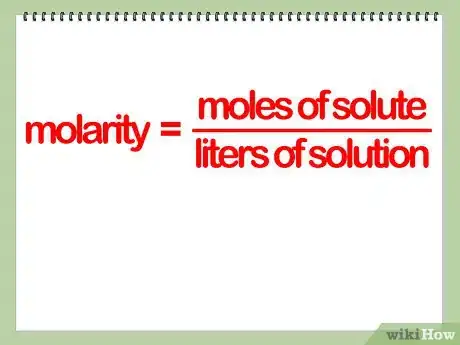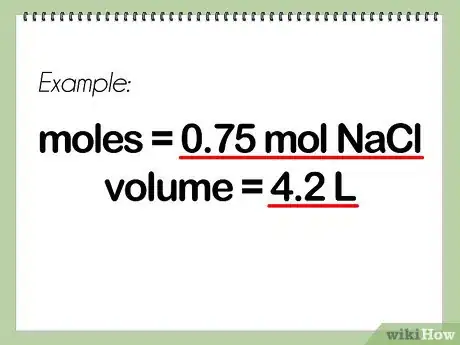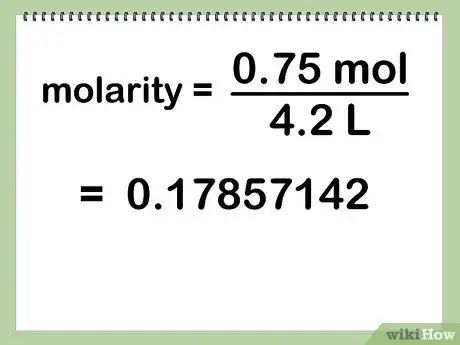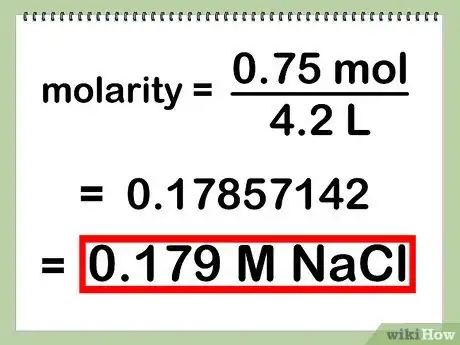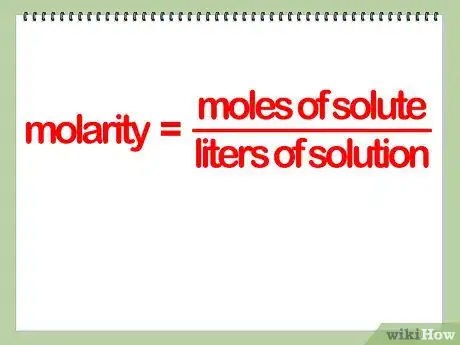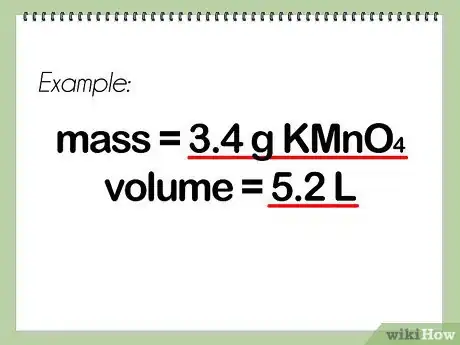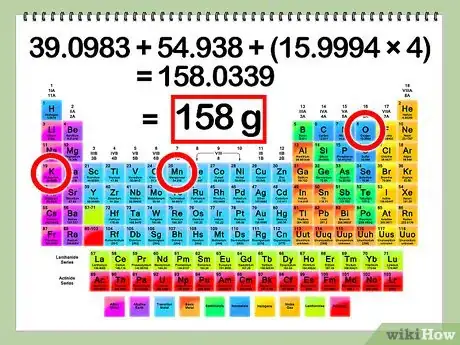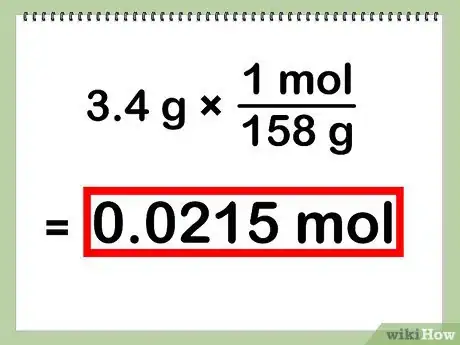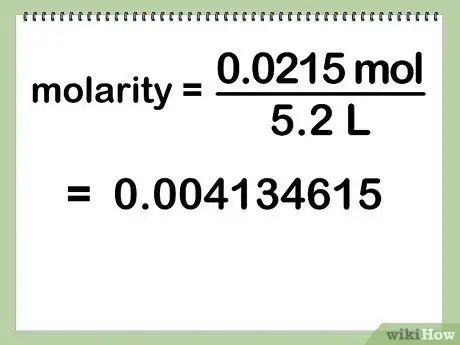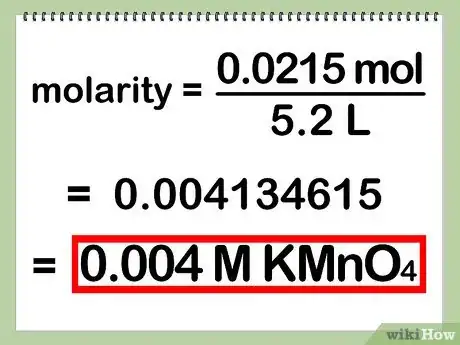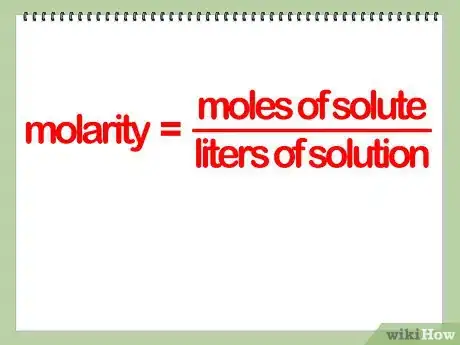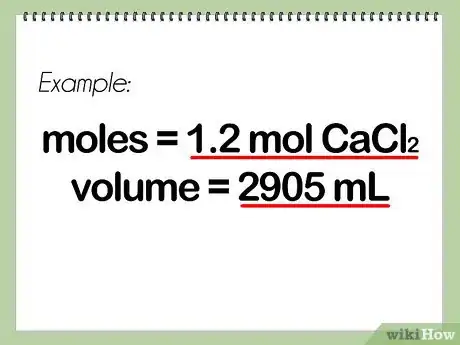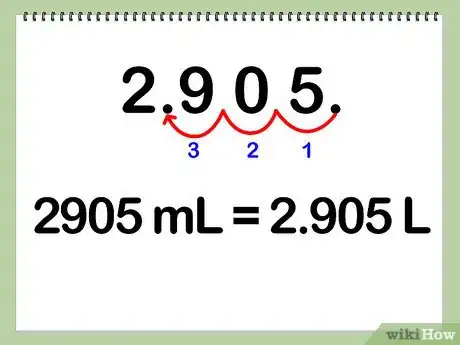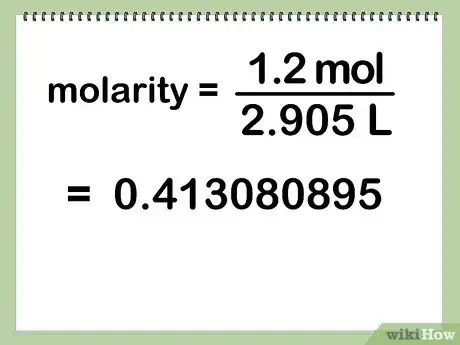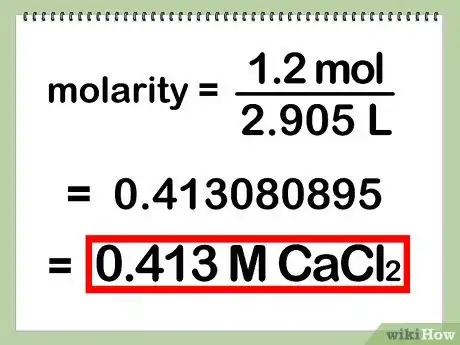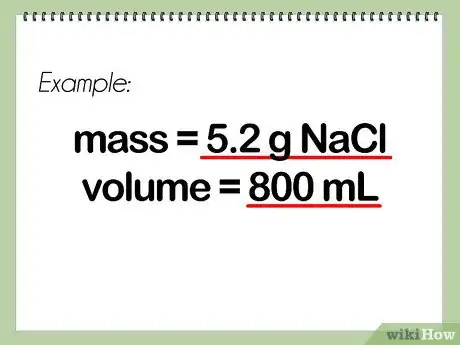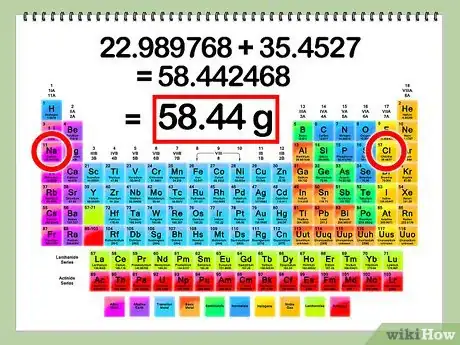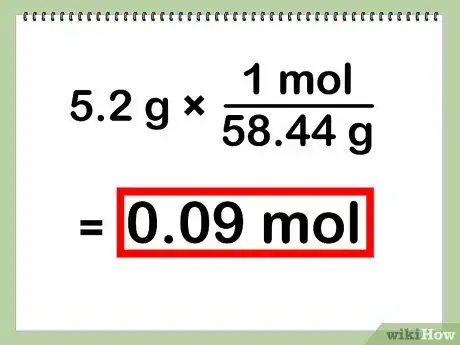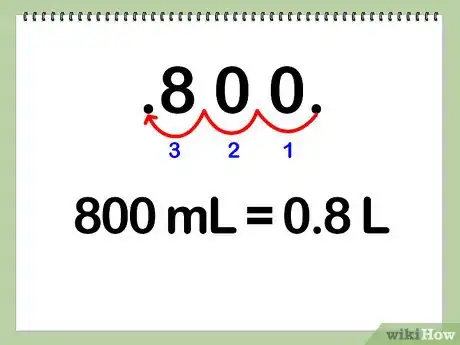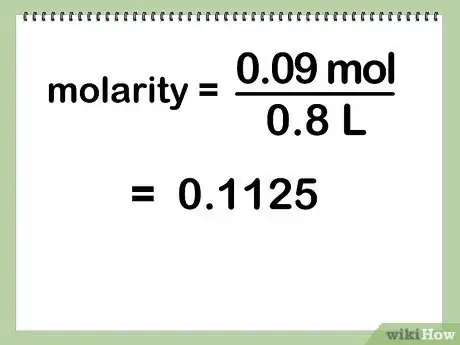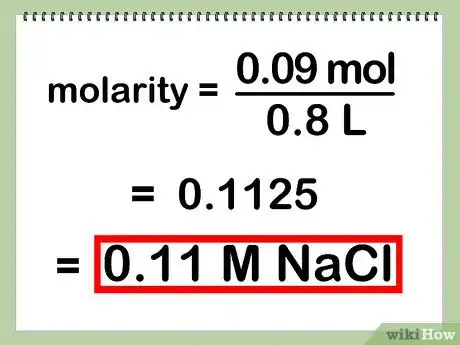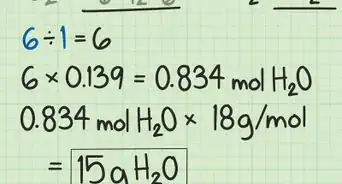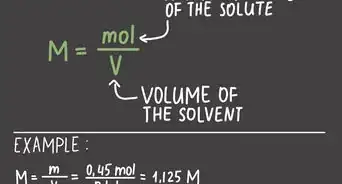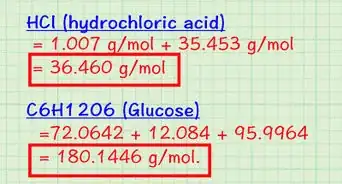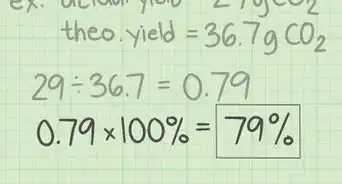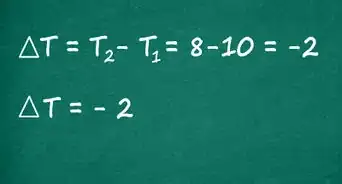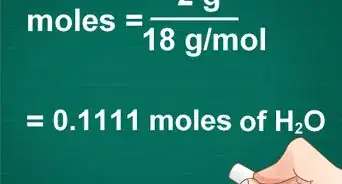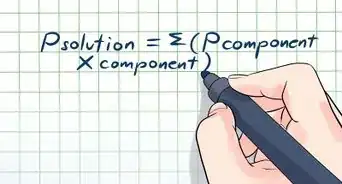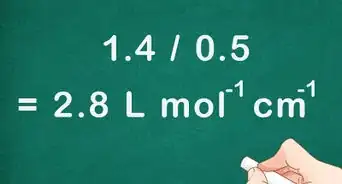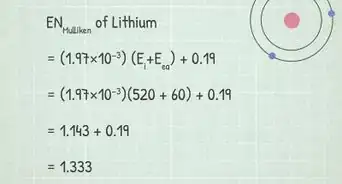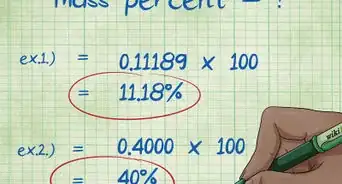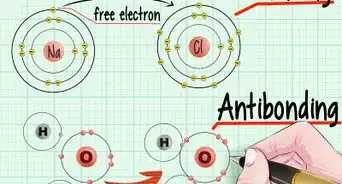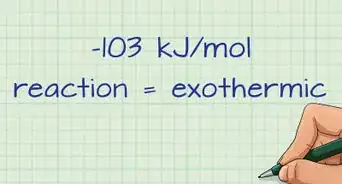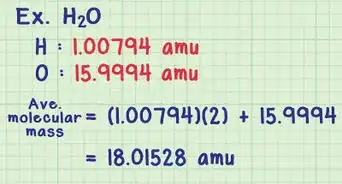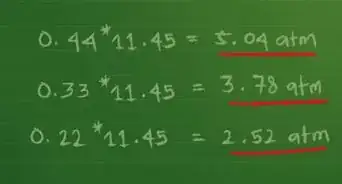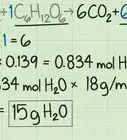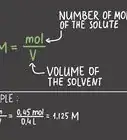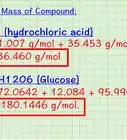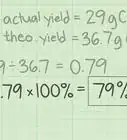This article was co-authored by Bess Ruff, MA. Bess Ruff is a Geography PhD student at Florida State University. She received her MA in Environmental Science and Management from the University of California, Santa Barbara in 2016. She has conducted survey work for marine spatial planning projects in the Caribbean and provided research support as a graduate fellow for the Sustainable Fisheries Group.
wikiHow marks an article as reader-approved once it receives enough positive feedback. This article received 28 testimonials and 80% of readers who voted found it helpful, earning it our reader-approved status.
This article has been viewed 1,618,637 times.
Molarity describes the relationship between moles of a solute and the volume of a solution.[1] To calculate molarity, you can start with moles and volume, mass and volume, or moles and milliliters. Plugging these variables into the basic formula for calculating molarity will give you the correct answer.
Steps
Calculating Molarity with Moles and Volume
-
1Know the basic formula for calculating molarity. Molarity is equal to the number of moles of a solute divided by the volume of the solution in liters. As such, it is written as: molarity = moles of solute / liters of solution.[2]
- Example problem: What is the molarity of a solution containing 0.75 mol NaCl in 4.2 liters?
-
2Examine the problem. Finding molarity demands that you have the number of moles and the number of liters. If the problem provides each of these figures, no preliminary calculations are needed.
- Example problem:
- Moles = 0.75 mol NaCl
- Volume = 4.2 L
Advertisement - Example problem:
-
3Divide the number of moles by the number of liters. The resulting quotient will give you the number of moles per liter of solution, otherwise known as molarity.[3]
- Example problem: molarity = moles of solute / liters of solution = 0.75 mol / 4.2 L = 0.17857142
-
4Write your answer. Round off the number of digits after the decimal point to two or three, depending on your instructor's preference. When you write out the answer, abbreviate "molarity" with "M" and state the chemical abbreviation of the solute involved.
- Example problem: 0.179 M NaCl
Calculating Molarity with Mass and Volume
-
1Know the basic formula for calculating molarity. Molarity expresses the relationship between the number of moles of a solute per liters of solution, or the volume of that solution. In formula form, molarity is expressed as: molarity = moles of solute / liters of solution.[4]
- Example problem: What is the molarity of a solution made by dissolving 3.4 g of KMnO4 in 5.2 liters of water?
-
2Examine the problem. Finding molarity demands that you have the number of moles and the number of liters. If you are not provided with the number of moles but you do have the volume and mass of the solution, you will need to use these two figures to calculate the number of moles before continuing on.
- Example problem:
- Mass = 3.4 g KMnO4
- Volume = 5.2 L
- Example problem:
-
3Find the molar mass of the solute. To calculate the number of moles from the mass or grams of solute used, you must first determine the molar mass of the solute.[5] This can be done by adding together the separate molar masses of each element found in the solution. Find the molar mass of each element using the periodic table of elements. Make sure that you count the atoms for each element and calculate the molar mass of each of the atoms.
- Example problem:
- Molar mass of K = 39.1 g
- Molar mass of Mn = 54.9 g
- Molar mass of O = 16.0 g (The solute contains 4 O atoms, so count the 16g 4 times.)
- Total molar mass = K + Mn + O + O + O + O = 39.1 + 54.9 + 16 + 16 + 16 + 16 = 158.0 g
- Example problem:
-
4Convert the grams into moles. Now that you have the molar mass of the solute, you need to multiply the number of grams of solute in the solution by a conversion factor of 1 mole over the formula weight (molar mass) of the solute. This will give you the number of moles of the solute for this equation.[6]
- Example problem: grams of solute * (1/molar mass of solute) = 3.4 g * (1 mol / 158 g) = 0.0215 mol
- The grams units of the solute and solute mass cancel each other out so you are left with mol units.
-
5Divide the number of moles by the number of liters. Now that you have the number of moles, you can divide this value by the number of liters of solution in order to find the molarity.[7]
- Example problem: molarity = moles of solute / liters of solution = 0.0215 mol / 5.2 L = 0.004134615
-
6Write your answer. You should round off the number of digits after the decimal point to the place requested by your instructor. Usually, this will be two or three places after the decimal point. Additionally, when you write out the answer, abbreviate “molarity” with “M” and state the solute involved.
- Example problem: 0.004 M KMnO4
Calculating Molarity with Moles and Milliliters
-
1Know the basic formula for calculating molarity. In order to find molarity, you need to calculate the number of moles of solute for a solution per liter of solution. Milliliters cannot be used. The general formula used to express molarity is written as: molarity = moles of solute / liters of solution.[8]
- Example problem: What is the molarity of a solution containing 1.2 moles CaCl2 in 2905 milliliters?
-
2Examine the problem. Calculating molarity requires you to have the number of moles and the number of liters. If you are provided with the volume in milliliters instead of liters, you will need to convert the volume into liters before continuing your calculations.
- Example problem:
- Moles = 1.2 mol CaCl2
- Volume = 2905 ml
- Example problem:
-
3Convert the milliliters into liters. Find the number of liters by dividing the number of milliliters by 1000, since there are 1000 milliliters per 1 liter.[9] Note that you could also simply move the decimal point to the left three places.
- Example problem: 2905 ml * (1 L / 1000 ml) = 2.905 L
-
4Divide the number of moles by the number of liters. Now that you have the number of liters, you can divide the number of moles of solute by this value in order to find the molarity of the solution.[10]
- Example problem: molarity = moles of solute / liters of solution = 1.2 mol CaCl2 / 2.905 L = 0.413080895
-
5Write your answer. Round off the number of digits after the decimal point to the amount requested by your instructor (usually two or three places). When you write out the answer, you should also abbreviate “molarity” with “M,” and state the solute.
- Example problem: 0.413 M CaCl2
Additional Practice Problem
-
1Find the molarity of a solution made by dissolving 5.2 g of NaCl in 800 ml of water. Identify the values provided to you in the problem: mass in grams and volume in milliliters.
- Mass = 5.2 g NaCl
- Volume = 800 ml water
-
2Find the molar mass of NaCl. Do this by adding together the molar mass of sodium, Na, and the molar mass of chlorine, Cl.
- The molar mass of Na = 22.99 g
- The molar mass of Cl = 35.45 g
- The molar mass of NaCl = 22.99 + 35.45 = 58.44 g
-
3Multiply the mass of the solute by its molar mass conversion factor. In this instance, the molar mass of NaCl is 58.44 g, so the conversion factor is 1 mol / 58.44 g.
- Moles NaCl = 5.2 g NaCl * (1 mol / 58.44 g) = 0.08898 mol = 0.09 mol
-
4Divide 800 ml of water by 1000. Since there are 1000 milliliters per liter, you will need to divide the number of milliliters in this problem by 1000 in order to find the number of liters.
- You could also look at it as multiplying 800 ml by a conversion factor of 1 L / 1000 ml.
- To hasten the process, you could simply move the decimal point three places to the left instead of multiplying or dividing anything.
- Volume = 800 ml * (1 L / 1000 ml) = 800 ml / 1000 ml = 0.8 L
-
5Divide the number of moles of solute by the number of liters of solution. In order to find the molarity, you need to divide 0.09 mol, the number of moles of the solute NaCl, by 0.8 L, the volume of the solution in liters.
- molarity = moles of solute / liters of solution = 0.09 mol / 0.8 L = 0.1125 mol/L
-
6Tidy up your answer. Round your answer off to two or three decimal places and abbreviate molarity with “M.”
- Answer: 0.11 M NaCl
Community Q&A
-
QuestionWhat is the formula for a mole?
 Community AnswerNo. of moles = (Given mass of compound in the question)/Molecular mass of the given compound
Community AnswerNo. of moles = (Given mass of compound in the question)/Molecular mass of the given compound -
QuestionWhat is the difference between molarity and molar mass?
 Community AnswerMolarity is a measure and unit of concentration. It is used to express concentration of a particular solution. On the other hand, molar mass is a unit of mass. It is the mass of 1 mole of a substance.
Community AnswerMolarity is a measure and unit of concentration. It is used to express concentration of a particular solution. On the other hand, molar mass is a unit of mass. It is the mass of 1 mole of a substance. -
QuestionHow can I calculate molarity if concentration is given as percentage?
 Community AnswerConvert the percentage to a decimal by moving the decimal point left two places. For example; 98% would become 0.98, and 6% would become 0.06.
Community AnswerConvert the percentage to a decimal by moving the decimal point left two places. For example; 98% would become 0.98, and 6% would become 0.06.
References
- ↑ https://www.chemicool.com/definition/molarity.html
- ↑ https://www.omnicalculator.com/chemistry/molarity
- ↑ https://www.omnicalculator.com/chemistry/molarity
- ↑ https://www.khanacademy.org/science/chemistry/states-of-matter-and-intermolecular-forces/mixtures-and-solutions/a/molarity
- ↑ https://www.chem.purdue.edu/gchelp/howtosolveit/Solutions/determinemolarmass.html
- ↑ https://sciencing.com/determine-moles-solute-8483482.html
- ↑ https://www.khanacademy.org/science/chemistry/states-of-matter-and-intermolecular-forces/mixtures-and-solutions/a/molarity
- ↑ https://www.khanacademy.org/science/chemistry/states-of-matter-and-intermolecular-forces/mixtures-and-solutions/a/molarity
- ↑ https://www.inchcalculator.com/convert/milliliter-to-liter/
About This Article
To calculate molarity, divide the number of moles of solute by the volume of the solution in liters. If you don't know the number of moles of solute but you know the mass, start by finding the molar mass of the solute, which is equal to all of the molar masses of each element in the solution added together. Once you have the molar mass, multiply the number of grams of solute by 1 over the molar mass to convert the grams into moles. Finally, divide the number of moles by the volume of the solution to get the molarity. To learn how to calculate molarity using moles and milliliters, scroll down!
